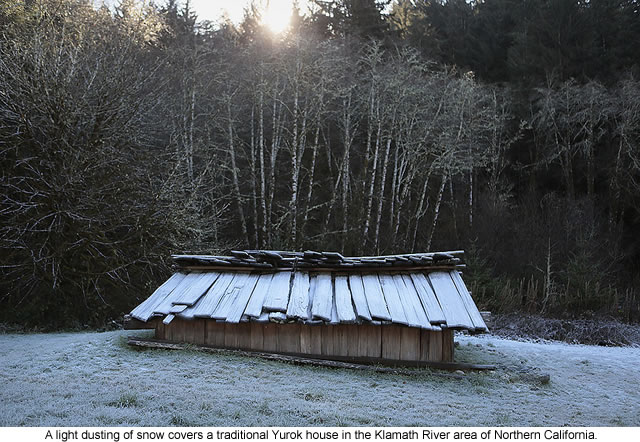 |
Canku Ota
|
 |
|
(Many Paths)
|
||
|
An Online Newsletter
Celebrating Native America
|
||
|
February 2013 - Volume
11 Number 2
|
||
|
|
||
|
Revival of Nearly
Extinct Yurok Language is a Success Story
|
||
|
by Lee Romney - Los
Angeles Times
|
||
|
The number of
native speakers fell to six at one point. But tribal leaders would
not let Yurok die, and some Northern California schools are now
teaching it.
EUREKA, Calif. — Carole Lewis throws herself into her work as if something big is at stake.
For thousands of years before Western settlers arrived, the Yurok thrived in dozens of villages along the Klamath River. By the 1990s, however, academics had predicted their language soon would be extinct. As elders passed away, the number of native speakers dropped to six. But tribal leaders would not let the language die. Last fall, Eureka High became the fifth and largest school in Northern California to launch a Yurok-language program, marking the latest victory in a Native American language revitalization program widely lauded as the most successful in the state. At last count, there were more than 300 basic Yurok speakers, 60 with intermediate skills, 37 who are advanced and 17 who are considered conversationally fluent. If all goes as planned, Lewis' 20 students will move on to a second year of study, satisfying the world language requirement for admission to University of California and Cal State schools. But the teacher and tribe have some longer-term goals: boosting Native American high school graduation rates and college admissions numbers; deepening the Yurok youths' bonds to their culture; and ensuring that their language will regain prominence after half a century of virtual silence. The decimation of the language dates to the first half of the 20th century, when tens of thousands of Native American youngsters across the country, Lewis' mom among them, were sent to government-run boarding schools. The effort to assimilate the youth into Euro-American culture pressed them to abandon their own. Often they were beaten for speaking in their native tongues. "The schools had a big negative impact on us. It's how we lost our language," said James Gensaw, 31, among the small staff of the tribal language program led by Lewis, 62. "Now the schools are helping us to keep it alive."
Jim McQuillen edged his SUV down Highway 101 from Crescent City and into the heart of Yurok ancestral territory. From Requa Hill — dotted with burial grounds — the tribe's education director pointed out 'O Re-gos, a rock shaped like a woman carrying a burden basket that is considered the spirit keeper of the mouth of the Klamath River. A long sandbar blocks the river's exit, fostering a rich ecosystem. When the current breaks through into the ocean on the south side of the sandbar, one legend goes, the legs of 'O Re-gos are outstretched. When the mouth moves south, they are curled to her chest. Tribal members netted 80,000 salmon here last year. Canoes hand-built from fallen redwood ply the waters. The ancient ways have seen a revival over the last 25 years or so, as have once-banned cultural traditions such as the White Deerskin Dance, part of a 30-day renewal ceremony meant to balance the physical and spiritual worlds. For youth, the knowledge matters, said McQuillen, 50. "If they come from a family that was very bonded with the dances, they tend to do very well in higher ed. We call it success in both worlds." But language revitalization proved complex.
Thompson made his way back to his grandmother's ranch on the banks of the Klamath and was steeped in the language throughout his high school years. He hooked eels in the river and netted so many candlefish — kwo'ror' — that the bottom of his boat turned white. He is among the few remaining original speakers. But he raised his own eight kids in English, the language of accomplishment. It's a familiar story. Like others of their generation, McQuillen and his seven siblings didn't hear their fluent mother speak much Yurok. They knew the names for animals and birds, and couldn't help but soak up the scoldings: "to'-woh" (That's enough!) or "Nee mokw we chpey-geyr'" (don't you have ears?) Some revival efforts began in the 1970s, but they did not take off until after the nearly 6,000-member tribe received federal recognition and formed a government in 1992. Soon Lewis was recruited, securing a grant from the federal Administration for Native Americans. She launched a master/apprentice program to pair elders with new learners and hired Barbara McQuillen, Jim's sister and now the language program's assistant coordinator. . Over the years, Lewis and McQuillen have worked with kids in elementary school, high school, after-school programs, preschoolers at the tribal-run Head Start program and adults in community classes. Both had learned Yurok from elders, who soaked it up as babies with no knowledge of the rules of grammar. "The elders would say things one way one time and another way another time," McQuillen said. When asked why, they often could not answer. Then in 2001, UC Berkeley linguists launched the Yurok Language Project. Professor Andrew Garrett and a colleague reworked an early grammar guide and collaborated with elders on a dictionary. The online written and audio version of the dictionary has been hailed as a national model. There are sounds not found in English — "hl," for instance, made by putting the tongue against the back of the front teeth and blowing air out on both sides of the mouth, and "ew," which Lewis jokes is used in English only by Elmer Fudd when he says "I will." The language also shines light on the Yurok worldview. The counting system depends on whether what's counted is round or flat, human or animal. There are no general terms for squirrel, owl or hawk — only names for specific types. And certain terms have no true English counterpart: Mue-neech, for example, translates as "a foolish action," which misses the nuance. "When Coyote tries to do something to make himself look really good, and winds up looking really bad," Lewis said, "that's mue-neech."
California is home to more than 80 Native American languages, making it the most diverse linguistic region in the Western hemisphere. And among revitalization efforts, Garrett said, the Yurok program has been "astonishingly successful." Key to that was the push into the public schools. But making it happen wasn't easy: Yurok-language instructors in most instances lacked California teaching credentials. The elders who first offered high school instruction — one as far back as the 1970s — were granted eminence credentials, or special waivers. When McKinleyville High School relaunched its program in 2005 after a long lull, there were four students. There are now 23, said instructor Kathleen Vigil, who co-taught with her mother until the elder woman died four years ago at 95. To accommodate Vigil, the school has assigned a credentialed teacher to sit in class with her. But it became clear a few years ago that such arrangements would not fly in larger districts. Lewis and the director of Indian education at Hoopa Valley High raised the issue at a statewide conference — and the Santa Ynez Band of Chumash Indians, a tribe with gaming resources, stepped up to press for legislation. The Assembly bill signed into law in late 2009 requires the California Commission on Teacher Credentialing to issue an "American Indian languages credential" to teachers recommended by federally recognized tribes that are authorized to establish their own fluency tests.
On a recent day, he reviewed the words for birds with a squirming class of Klamath preschoolers. "Terkerkue," they squealed when shown an image of a quail. The tribe has pushed for high school classes to be scheduled in the early morning — to get students there and keep them there. It seems to be working. Alex Gensaw lives next door to tribal elder Archie Thompson and craved a deeper connection to his culture. He came into McQuillen's class three years ago knowing only 10 words of Yurok: It wasn't spoken in his home. But the 16-year-old (a second cousin to Yurok teacher James Gensaw) now is teaching his mom. And his feelings about the high school have shifted. "It's like they care more," he said. A number of non-native students have enrolled in Lewis' Eureka High class, approved by the school board last summer as a pilot program. Principal Rick Jordan said he hopes the program will become permanent. "Ideally we'll be able to look back and say, 'Hey, we helped save a language,'" Jordan said. "How great is that?"
|
|
|
||
|
|
||
| Canku Ota is a free Newsletter celebrating Native America, its traditions and accomplishments . We do not provide subscriber or visitor names to anyone. Some articles presented in Canku Ota may contain copyright material. We have received appropriate permissions for republishing any articles. Material appearing here is distributed without profit or monetary gain to those who have expressed an interest. This is in accordance with Title 17 U.S.C. Section 107. | ||
|
Canku Ota is a copyright ©
2000 - 2013 of Vicki Williams Barry and Paul Barry.
|
||
 |
 |
|
|
The "Canku
Ota - A Newsletter Celebrating Native America" web site and
its design is the
|
||
|
Copyright ©
1999 - 2013 of Paul C. Barry.
|
||
|
All Rights Reserved.
|
||
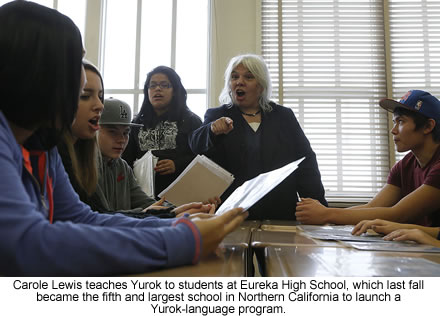 "Pa'-ah,"
she tells her Eureka High School class, gesturing at a bottle of
water. She whips around and doodles a crooked little fish on the
blackboard, hinting at the dip she's prepared with "ney-puy" —
salmon, key to the diet of California's largest Native American
tribe.
"Pa'-ah,"
she tells her Eureka High School class, gesturing at a bottle of
water. She whips around and doodles a crooked little fish on the
blackboard, hinting at the dip she's prepared with "ney-puy" —
salmon, key to the diet of California's largest Native American
tribe.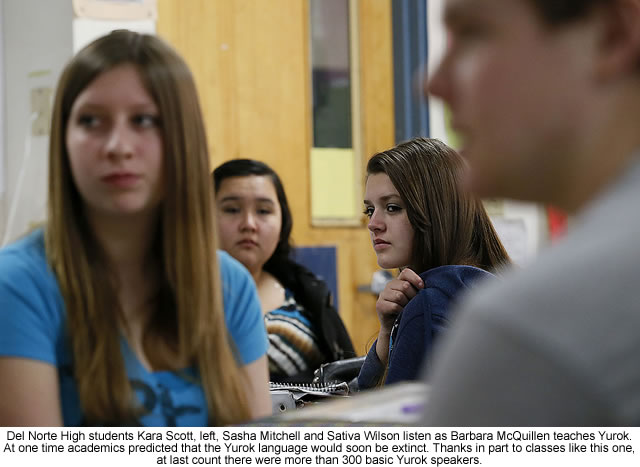
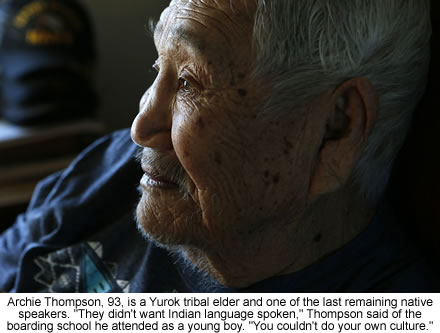 Decades
of dissuasion had silenced the tribal elders. As a 5-year-old, Archie
Thompson attended boarding school in Hoopa Valley. "They didn't
want Indian language spoken," recalled Thompson, now 93 with a rich
head of gray hair and a luminous smile. "You couldn't do your own
culture."
Decades
of dissuasion had silenced the tribal elders. As a 5-year-old, Archie
Thompson attended boarding school in Hoopa Valley. "They didn't
want Indian language spoken," recalled Thompson, now 93 with a rich
head of gray hair and a luminous smile. "You couldn't do your own
culture."
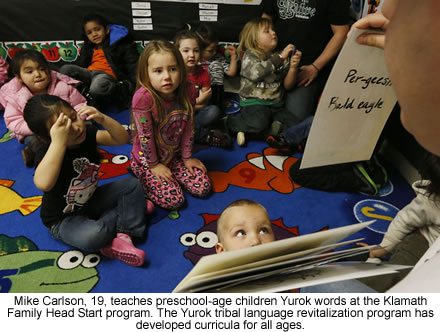 By
2010, Barbara McQuillen was teaching Yurok at Crescent City's Del
Norte High School. Mike Carlson, 19, who graduated last year, is
now an apprentice instructor.
By
2010, Barbara McQuillen was teaching Yurok at Crescent City's Del
Norte High School. Mike Carlson, 19, who graduated last year, is
now an apprentice instructor.